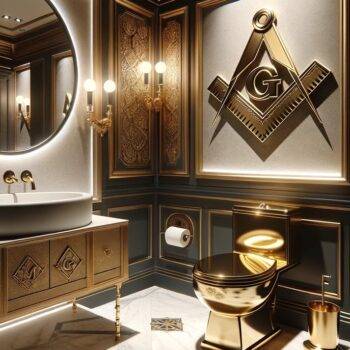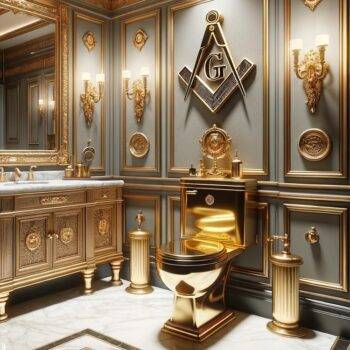The Freemasons, a fraternal organization known for its secretive rituals and ancient traditions, have long been a subject of intrigue and fascination. While the Freemasons are primarily recognized for their commitment to principles of brotherhood, charity, and moral development, there is another aspect of their world that has piqued the curiosity of many: their connection to luxury and opulence, particularly when it comes to gold elements in interior design. In this article, we will delve into the captivating realm of Freemasons and their penchant for luxury, focusing on the use of gold in their interior design, including the infamous gold toilets that have garnered much attention.

Freemasonry converges with the pursuit of a luxury lifestyle, highlighting a shared appreciation for craftsmanship, exclusivity, and the symbolic power of gold.
Before we explore the extravagant elements of Freemasonry, it’s essential to understand the organization’s core principles. Freemasonry is rooted in ancient traditions, rituals, and symbolism, dating back centuries. Its members, known as Freemasons or Masons, are bound by a commitment to moral and ethical values, as well as charitable endeavors. The symbolism within Freemasonry is rich and deeply ingrained in its rituals, with symbols like the square and compass representing moral rectitude and self-improvement.
Contrary to its reputation for secrecy and solemnity, Freemasonry has occasionally been associated with luxury and opulence, particularly when it comes to the design and decoration of Masonic temples and lodges. This association with luxury may be partly attributed to the organization’s historical roots, where many influential and affluent individuals were part of the Masonic brotherhood.
One of the most striking aspects of the Freemasons’ love for luxury is their use of gold elements in interior design. Gold, with its undeniable allure and symbolic significance, has been a prominent feature in Masonic lodges and temples. Here are some ways in which gold has been incorporated into Freemasonic interior design:

In the context of Freemasonry, the gold toilet can be viewed as a modern-day emblem of splendor and exclusivity, mirroring the organization’s historical gravitation towards symbols of nobility and distinction.
Perhaps the most infamous example of luxury within Freemasonry is the presence of luxury gold toilets in some Masonic lodges. These toilets, featuring gold plating, have made headlines and fueled speculation about the organization’s extravagance. It’s important to note that not all Masonic lodges have gold toilets, and their presence is more of an exception than a rule.
While the existence of gold toilets may seem excessive, they are not necessarily indicative of Freemasonry as a whole. The use of such luxurious fixtures can be attributed to the preferences of specific lodge members or the desire to create a unique and memorable experience within a particular lodge.
Conclusion
The Freemasons are an organization steeped in tradition, symbolism, and principles of moral development. While they are primarily known for their commitment to brotherhood and charity, certain aspects of Freemasonry have been associated with luxury and opulence, including the use of gold elements in interior design. The presence of gold in Masonic temples and lodges serves to create an ambiance of grandeur and significance, enhancing the experience of Masonic rituals. While the inclusion of gold toilets in some lodges may raise eyebrows, it’s important to remember that Freemasonry is a diverse organization with a wide range of lodges, each with its unique traditions and preferences. Ultimately, the fascination with Freemasons and their luxury lifestyle provides a glimpse into a world where symbolism and opulence coexist, inviting us to explore the depths of an enigmatic fraternity.